
Plenty of job-seekers spend weeks, and even months, looking for a job. It can be a slow and demoralizing process where you don’t get a single response after dozens of applications.
This is where perfecting your CV can make a real difference.
Your CV is the document that could open the door to your dream job. If you get it right, you can expect interview calls left and right.
But how can you make sure you have a job-winning CV?
Well, we have an answer.
And while it may be a little bit long, it’s worth every second of your time.
If you want to perfect your CV, you have to grease up your elbows, get your reading glasses, and make sure every little detail is polished to perfection. Once you do that, believe us – it’s going to be worth it.
By building the perfect CV, you’re investing in yourself, and you’re increasing your chances of landing your next gig.
And our article is here to help!
We’re going to guide you through everything you need to know about making a CV, such as:
- The 7 Steps to Writing a CV
- 13+ Helpful Tips to Enhance Your CV
- 19 Real-Life CV Examples for Different Professions
…and much more!
So, let’s get into it.
Do You Need a CV or a Resume?
You might have noticed that when you’re applying for a job, some employers ask for a CV, while others prefer your resume.
But how do the two differ?
The answer depends on where you’re from.
In most of the world, including all of Europe and Asia, a CV and a resume are the same thing and are often used interchangeably. So if you’re applying for a job that asks for a CV, you should know that it’s the same as a resume.
Now, if you’re applying for a job in North America, it’s a bit different.
In the United States, a resume is a one-page summary of your skills and professional experience.
Meanwhile, a CV is a lot more detailed. Curriculum vitae is the Latin term for “course of life,” and it’s meant to include all your experience so far, including all levels of education, publications, projects, and more.
Typically, a CV is only required in the US and Canada when you’re applying for an academic or research position. Unlike a resume, which should only be one or two pages at most, an academic CV can be as long as necessary.
This guide is going to focus on how to write a CV for a regular job search. If you need to write an academic CV for a position in academia, check out our article for that instead.
How to Make a (Perfect!) CV
Most job-seekers use the default Word templates to create their CVs.
The problem here is that those default templates are often bland and don’t make your CV stand out. You want your job application to immediately capture the hiring manager’s attention, not blend in with the rest.
Setting up your CV template is also a very time-consuming process.
You’ll spend hours trying to make your CV’s contents fit within the template’s layout. And then, just when you’re at the finish line, you make one tiny tweak, and the whole thing gets completely messed up.
Now you’re back to where you started, looking for a CV template that’s easier to work with.
So why not take a shortcut?
Just use our CV builder and skip the hassle. Novorésumé lets you create a one-page CV for free, and it’s super easy to customize.
And the best part?
All of our CV templates are created in cooperation with hiring managers from around the world to make sure your CV is industry-ready, stylish, and optimized for the Applicant Tracking Systems (ATS) that most companies use.
Here’s how one of our CVs and one made with a regular text editor template compare with each other:
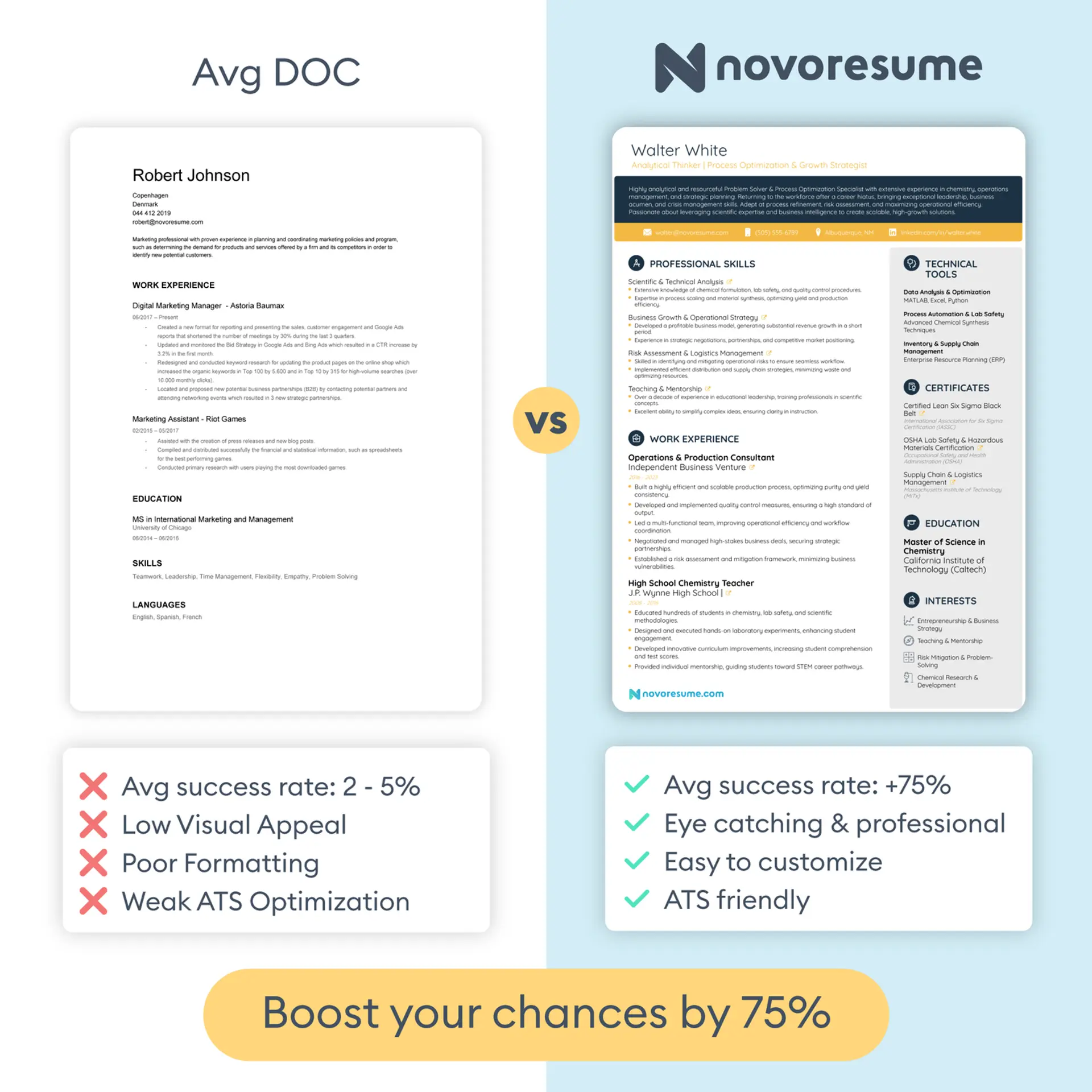
What to Include in Your CV
Alright, let’s get down to brass tacks. So, what goes into a CV, exactly?
Now, there is no golden rule, and not every CV has the same sections. A lot depends on your level of experience and what exactly you’re applying for.
Let’s look at the most common sections you can choose from.
The Must-have Sections to Include in a CV:
- Contact information
- CV Summary or objective
- Work experience
- Skills
- Education
Optional Sections to Include in a CV:
- Certifications
- Awards and Honors
- Languages
- Personal Projects
- Volunteer Experience
We’re going to look at each of these sections and guide you through writing them, step by step.
#1. Choose the Best CV Format
Before you start filling in the contents of your CV, you have to make sure it’s going to be reader-friendly and look good.
The first thing hiring managers notice is what your CV looks like, and then decide whether to read it. So, this is your chance to make a strong first impression.
This is where your CV format comes in.
Like with resume formats, there are three different formats you can choose from:
- Reverse-chronological. This is by far the most popular CV format among hiring managers worldwide, so it’s the best choice for most job-seekers.
- Functional. This CV format focuses more on skills than work experience. It’s a good choice if you’re just getting started with your career and have little to no experience.
- Combination. The combination CV format is a great choice for experienced job-seekers with a very diverse set of skills. It’s useful if you’re applying for a role that requires expertise in several different fields and you want to show all that in your CV.
So, which one should you choose?
In 99% of cases, you want to stick to the reverse-chronological CV format. It’s the most popular format, and it’s what hiring managers expect to see.
For this reason, the rest of this article will teach you how to make a reverse-chronological CV.
And Don’t Forget About Your CV’s Layout
Your CV’s layout is just as important as its format.
The layout is what determines whether your CV looks organized or cluttered, whether it ends up being too short or too long, and ultimately, if it’s boring and unimpressive or attention-grabbing and easy on the eyes.
Here are some CV layout tips you should keep in mind:
- Keep it to one page. You should only go for a two-page CV if you’re sure you can’t summarize yourself on one page. Don’t waste precious space on your CV on your life story – no one’s going to read it!
- Use clear and consistent section headings. Pick a heading and use it for all the section headers so the hiring manager can easily navigate through your CV. Keep the colors and font size consistent so your CV is easy on the eyes.
- Leave ample white space. Without the right amount of white space, your CV will end up looking cluttered with information. Just set your page margins to one inch on all sides so your text fits just right on the page.
- Pick a professional font. We’d recommend sticking to a font that’s professional but not overused. For example, fonts like Ubuntu, Roboto, Lora, or Overpass. Avoid Times New Roman, and never use Comic Sans.
- Choose the correct font size. As a rule of thumb, go for 11-12 pt for normal text and 14-16 pt for section titles. This helps keep your details clear and keeps the hiring manager from having to squint to read your CV.
- Save it as a PDF file. Make sure to save your CV as a PDF file, unless the employer specifically requests a different file format. You don’t want to risk sending your CV in as a Word file and messing up your document’s formatting after you put in all that hard work.
Another thing you need to consider is whether you’re going for a classic-looking CV template or something modern.
If you’re pursuing a career in an industry like law, banking, or finance, you might want to stick to a traditional CV template.
But if you’re applying to a startup where individuality and innovation are part of the company's values, you can pick a creative CV template.
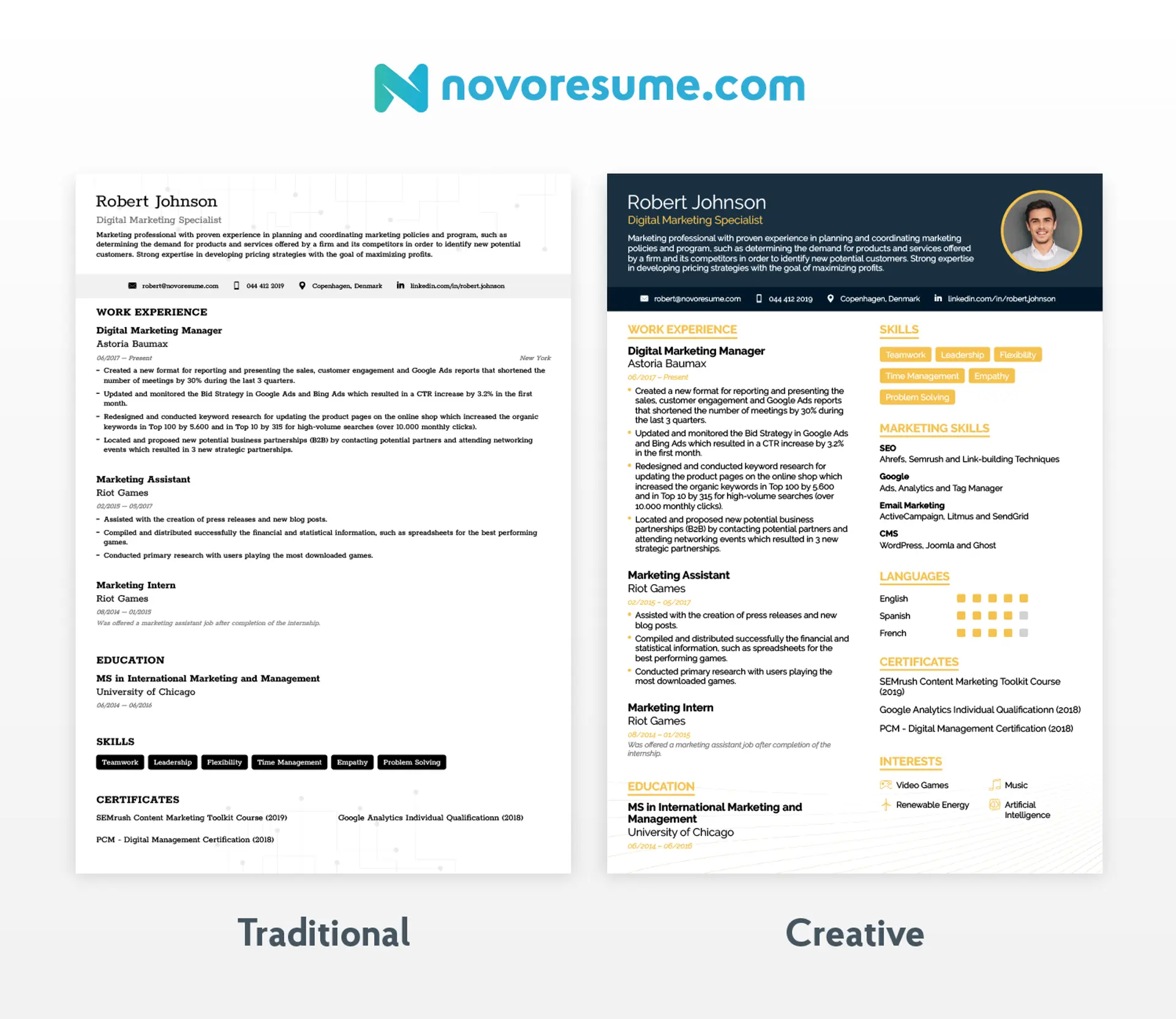
#2. Add Your Contact Information
Once you’ve done formatting your CV, you need to start filling it up with the right information.
The contact information section is easy to fill but important to get right. After all, even if you have the most impressive CV, it’s not going to matter much if the hiring manager can’t contact you.
So, neatly place your contact information at the top of your CV in a designated CV header, so the hiring manager can spot it right away.
Make sure you triple-check everything in this section so that there are no typos and everything is up to date.
What to Include in Your CV’s Contact Information Section:
Must-Have Information- Full name. Place this at the top of the page. The preferred format here is listing your first name and then your family name. (e.g.: John Smith, instead of Smith, John.)
- Email address. Use an email address that’s professional and easy to spell, like a combination of your names. (E.g.: john.smith@novoresume.com)
- Phone number. Add a reliable number where the hiring manager can easily reach you. Include the country dial code if you’re applying internationally.
- Location. Add your city and state/country. If you plan to relocate for the job or want a remote position, make sure to specify so on your CV.
Optional Information- Job title. Include your professional title underneath your name. Write it down word for word, whether it’s “Digital Marketing Specialist” or “Senior Copywriter.” Just don’t make up job titles like “Marketing Wizzard” or use funny job-title buzzwords.
- Social media. As long as it’s relevant, you can add links to any social media or other website that can help your case. For example, having a complete and optimized LinkedIn profile can increase your chances of getting an interview.
- Portfolio. If you’re looking for a job as an illustrator or other artistic position, you should provide a link to your portfolio. On the other hand, if you’re a software developer, you could include a link to your GitHub account instead.
It’s also important to know what information not to disclose on your CV.
This varies from country to country, so make sure to check what the common practices and laws around these are in the specific place where you’re applying for a job.
What to Avoid in Your CV’s Contact Information Section:
- Date of birth. Unless this is explicitly requested in the job ad, the hiring manager doesn’t need to know how old you are. It’s not important for their decision-making, and it could even lead to age-based discrimination.
- Unprofessional email address. Your quirky, old childhood email address doesn’t belong on your CV. Instead of themermazingmagdelene@hotmail.com, use a mature firstname.lastname@email.com email address.
- Headshot. (USA, UK or Ireland) In most English-speaking countries, it might even be illegal to include a picture of yourself on your CV. However, including a picture is the norm in most of Europe and Asia. Make sure to check the regulations for each specific country or industry you’re applying to before sending in your CV.
Now let’s look at an example of what a CV’s contact information section looks like:

#3. Write an Attention-Grabbing CV Headline
Research says that, on average, hiring managers look at CVs for up to six seconds at most!
That sounds a little harsh, right?
You spend days—weeks even—crafting the picture-perfect CV that represents you in a nutshell.
And what does the hiring manager do?
They glance it over for a few seconds (if you’re lucky!) and move on.
As unfair as that might be, how exactly are you supposed to capture someone’s attention in a matter of seconds?
This is where adding a brief paragraph at the top of your CV comes in.
Your CV headline should be right next to (or above) your contact information so that it’s the first thing the hiring manager reads.
Depending on your level of experience, your CV headline can be either a CV summary or an objective.

Both your CV summary and objective are your first attempt at grabbing the hiring manager’s attention. Make sure you use clear language so that the hiring manager doesn’t have to read your headline a few times to understand it—because they simply won’t read it.
Think of this as your elevator pitch. You need to convince the hiring manager to give you a shot within those six seconds of skimming your CV.
But if you’re not sure whether to use a CV summary or a CV objective, here’s a rundown of each:
CV Summary
As the name suggests, a CV summary is a brief recap of your career so far. If you do it right, it can show the hiring manager that you’re a qualified candidate in two to three sentences.
Here’s what your CV summary should include:
- Your job title and the amount of experience you have so far.
- A few of your greatest professional accomplishments or responsibilities.
- Your most impressive skills that match the job.
Now, let’s look at a well-written CV summary:
CV Summary Example:
Professional and creative architect with 10 years experience in developing construction drawings, 3D models, and doing design rendering. Served as a project architect at company X and won an honorable mention as a staff architect at XYZ Construction Awards 2023.
Usually, we recommend that job-seekers with work experience use a CV summary.
But if you’re a recent graduate, an entry-level professional, or you’re going through a career change, a CV objective might be a better choice.
CV Objective
A CV objective is meant to express your professional goals and aspirations and tie them in with your academic background and any relevant skills you might have for the position.
It’s two to four sentences long, and unlike a CV summary, a CV objective tells the hiring manager what your motivation is, so it’s the go-to CV headline for candidates with no work experience.
Here’s an example of what a student’s CV objective might look like:
Recent Graduate CV Objective:
Recent graduate with a Bachelor's degree in Finance, equipped with strong analytical and mathematical skills. Eager to launch my career in banking at XYZ Bank, where I can apply my knowledge gained through coursework and internships to help clients achieve their financial goals.
#4. Show Off Your Work Experience (the Right Way!)
You’ve made it this far, and now it’s time to really show the hiring manager that you’ve got what it takes for the job.
Your work experience section is the main section of your CV, and it’s where most hiring managers will jump when looking at your job application.
It’s also the deciding factor in whether you’ll get hired or not.
So, let’s start by showing you how to format your work experience correctly:
What to Include in Your Work Experience Section:
- Job title/position. Your job title goes on top of each work experience entry you include on your CV.
- Company name/location/description. Name the employer and include the general location, such as the city and state/country where you worked. In some cases, you can also briefly describe the company, particularly when the organization isn’t well-known.
- Dates employed. Add the approximate period of time that you were employed at each company. Don’t give exact dates; the standard format here is mm/yyyy.
- Achievements and responsibilities. What you did while employed is the core of each work experience entry. List your achievements and responsibilities in bullet points instead of paragraphs, so they’ll be easier for the hiring manager to read at a glance.
While it might sound straightforward, it can be tricky to sum up your work experience in just a few bullet points.
Most people just list their responsibilities next to the position.
While this approach is okay, it can only take you that far. Hiring managers likely know exactly what your responsibilities and day-to-day tasks were in your previous job. It’s your achievements they really care about.
So, you should take advantage of the work experience section to make it clear how you took the company from point A to point B.
Here’s an example of what a well-written CV’s work experience looks like:

Your work experience entries should always be listed in reverse chronological order, starting with more details about your most recent job and working their way back to the past.
CV Tips for Listing Work Experience
- Quantify your achievements. Whenever possible, always include concrete data that backs up your accomplishments. These can be percentages, budget amounts, or the amount of time a specific task or achievement took you to accomplish.
- Tailor your CV to the job ad. Make sure to tailor your CV to the specific job ad. Pay close attention to the requirements and focus on information that shows how you meet the employer’s needs.
- Incorporate keywords. Beating the ATS can take a little more effort. Add enough relevant keywords from the job ad so your CV makes it in front of a hiring manager.
- Use powerful action words. The hiring manager is bored of reading what you “managed” and what you were “responsible for.” Instead, make your CV sound more interesting by using powerful, attention-grabbing words, like facilitated, spearheaded, designed, conceptualized, etc.
💡
Quick Tip
Looking to write the perfect ATS-proof CV? Check out our guide here.
#5. Skills Section on Your CV
Next, it’s time to consider your skills.
Along with your work experience, the skills on your CV make up 90% of the hiring decision.
So, you want to make sure that your skills show that you’re the perfect candidate for the job.
There are two types of skills you should include on your CV:
- Hard Skills. These are measurable abilities that can range from using Photoshop to being able to solve complex mathematical equations. They’re directly related to your tasks.
- Soft Skills. Also known as personal skills, these are a mix of communication skills, personal traits, career attributes, and more. They can include leadership, critical thinking, and time management, just to name a few.
Here’s what your skills section would look like on your CV:
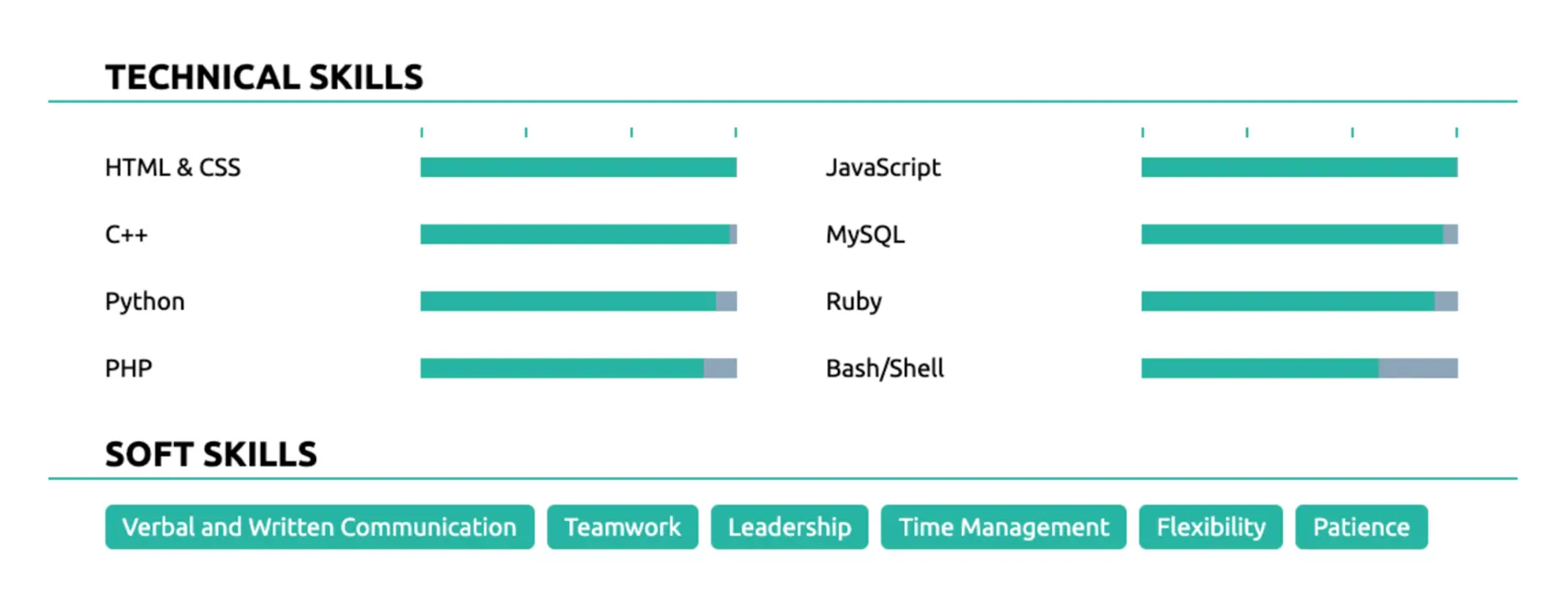
Follow these tips to format this section perfectly:
- Separate hard and soft skills. Keep your hard skills separated from your soft skills to make your CV easier to navigate.
- Tailor CV skills to the job ad. Carefully read the job ad and find out what the employer’s requirements are. Add any of the listed skills that you do have to your CV.
- Add experience levels for hard skills. Categorize your hard skills by proficiency so the employers know what to expect from you and how much training you might need.
- Include transferable skills. Regardless of the job you’re applying for, you probably have tons of skins that can come in handy for the position you’re applying for.
💡
Quick Tip
Wondering what skills to mention on your CV? Check out our list of 101+ essential skills for inspiration!
#6. Education Section on Your CV
Another important part is the education section of your CV.
Here’s how you should format it:
What to Include in Your CV’s Education Section:
Must-Have Information- Program Name. Your major and degree type should be listed first. (E.g.: “B.A. in Business Administration”)
- University Name. Add the name of the institution. (E.g.: “New York State University”)
- Dates Attended. Use a mm/yyyy format for the dates you attended. (E.g.: “08/2008 - 06/2012”)
Optional Information- Location. If your university is less well-known, you can also add the location. (E.g.: “Stockholm, Sweden”)
- GPA. Use the appropriate grading system for the country you’re applying to work in. (E.g.: In the USA, it would be “3.9 GPA”)
- Honors. Add any honors and distinctions you’ve been given. (E.g.: Cum Laude, Magna Cum Laude, Summa Cum Laude)
- Achievements. You can mention interesting papers you’ve written, projects you’ve done, or relevant coursework you’ve excelled in.
- Minor. “Minor in Psychology”
Let’s look at what this section can look like in practice:

You’ve got the basics now! Now, here are a few tips to keep in mind to perfect this section:
- If you’re making a CV as a student and don’t have any work experience yet, you can list your education section at the beginning of the page instead.
- You can add your expected graduation date if you’re still pursuing your degree.
- If you already have relevant work experience, just keep this section short and sweet.
- Recent graduates can expand on their education more and add optional information like projects, classes, academic achievements, etc.
- Always list your degrees in reverse chronological order, starting with your highest degree on top. Your highest and most recent degree is usually enough, so if you have a Master’s degree that’s relevant to the job, there’s no need to mention your earlier degrees.
- Don’t add your high school degree to your CV if you already have a university degree. It doesn’t have as much weight, and you can use the space for something else.
- Only mention your GPA if you had an impressive academic career. Anything below a 3.5 GPA doesn’t need to be on your CV.
💡
Quick Tip
Are you in the process of applying for college? Check out our guide to writing a college application CV to wow that admissions officer!
#7. Leverage Optional CV Sections
So far, we covered the most important CV sections that are mandatory for any job application.
Now, it’s time to take a look at the optional sections that can help you stand out.
Optional CV sections aren’t the biggest game-changers for your job hunt, but they’re a great option if you have some leftover space and want to spice up your application.
These include:
- Certifications. Continuous learning leaves a great impression on hiring managers. If you don’t have work experience in the field yet, showing you’ve taken the first step, such as a Coursera or Google Certificate, can show your genuine interest in the specific field.
- Awards and recognitions. Your CV is the best place to show off. Include any awards or acknowledgments, such as a hard-to-come-by scholarship.
- Publications. Whether you’re a freelance writer or a distinguished academic, relevant publications are always impressive. Make sure to include a link so the hiring manager can read your work.
- Languages. Being able to communicate in more than one language is always a bonus, so include your foreign languages and add your level of proficiency for each on your CV.
- Personal projects. If you worked on a mock software product during university or you run your product review YouTube channel, you can add it to your CV.
- Volunteer experience. Studies show that listing volunteer experience can increase your chances of getting hired, especially if you have less work experience. Volunteering shows you like meaningful work, which means you’re more likely to be a loyal employee.
- Hobbies and interests. While it’s still debated if hobbies or interests should ever make it onto a CV, adding a bit of extra information about yourself can give the hiring manager insight into you as a person and make you stand out. Some hobbies can even back up your skills, such as painting, which proves your creativity.
- Extracurricular activities. If you don’t have much experience outside of school, any clubs and activities you took part in can show employers how you honed certain skills or managed your time.
💡
Quick Tip
Trying to write your first CV as a college freshman? Check out our detailed guide to learn how!
13+ Expert CV Tips
You’ve got the gist of how to make a CV. Now, it’s time to make it really stand out from the crowd!
Follow these exclusive CV tips to take your CV game to the next level:
- Make sure that the professional title underneath your name matches the job title of the position you’re applying for. Hiring managers usually hire for several roles at once, so this can give them a cue about which job you’re after, and help things go smoother.
- Always mention promotions from your previous roles. Your work experience entries should highlight the specific achievements that helped you earn them.
- Use Laszlo Bock’s formula to describe your achievements: accomplished X as measured by Y by doing Z. This takes your work experience to the next level and clearly shows the hiring manager how you can contribute to their team.
- List your achievements and responsibilities in bullet points. This makes your CV easier to read, and it’s likelier that the hiring manager will see your impressive achievements while skimming through.
- Avoid personal pronouns like “I” or “me,” and never refer to yourself by name. Try an altered third person, such as “managed data integrity at XYZ Inc.” in place of “I managed data integrity at XYZ Inc.”
- The ATS might reject your CV unless the sections are named correctly. For example, names like “career history” or “expertise” should be “work experience” and "skills", respectively. It also makes it easier for the hiring manager to find what they’re looking for when reading your CV.
- Only include important keywords from the job ad, not all of them. The keywords you use, such as relevant skills, qualifications, and experiences need to make sense in context since you want to get past the ATS and impress the hiring manager.
- If you don’t have much relevant work experience, highlight your transferable skills. These can come from personal projects or extracurricular activities and help you stand out from other candidates.
- Use color strategically to make headings, bullet points, or key elements you want to highlight really pop. Just don’t use too much of it – the information on your CV should be more impressive than the design.
- Skip the line “references available upon request.” The hiring manager knows that they can request references from you, so don’t waste valuable CV space telling them they can.
- Your CV should be optimized for mobile devices. Hiring managers tend to use their mobile phones as often as desktop computers, and having your CV saved to a PDF file can ensure that your formatting stays the same across any device.
- Remember to change the name of the CV file you plan to send. It should include your name and the position you’re applying for. Skipping this small detail can leave a bad impression on the hiring manager.
- Try reading your CV out loud when you’re finished writing it. You might notice awkward phrases or spelling mistakes that you would have otherwise missed.
- Tools like DocSend can track your CV. Use it to get a notification whenever a hiring manager opens your CV, and to even track how long they spend looking at it.
3 Types of CVs
If you apply everything we’ve talked about so far, you should have a perfectly well-rounded CV. You’re prepared to take on the job market!
But just in case you aren’t sure what a great CV looks like, here are some examples of different types of CVs that you can use for inspiration.
#1. Graduate CV Example

Check out our full guide to writing a student CV here.
#2. Academic CV Example

Check out our full guide to writing an academic CV here.
#3. Executive CV Example

19 CV Examples for Different Jobs
Knowing how to write a CV is one thing, but making a CV that stands out is something entirely different. Without inspiration, even top career experts might stumble on a roadblock or two.
Check out the following effective CV examples for specific jobs to get a better sense of what a good CV looks like:
#1. Nurse Practitioner CV Example

Check out our full guide to writing a nurse CV here.
#2. Data Scientist CV Example
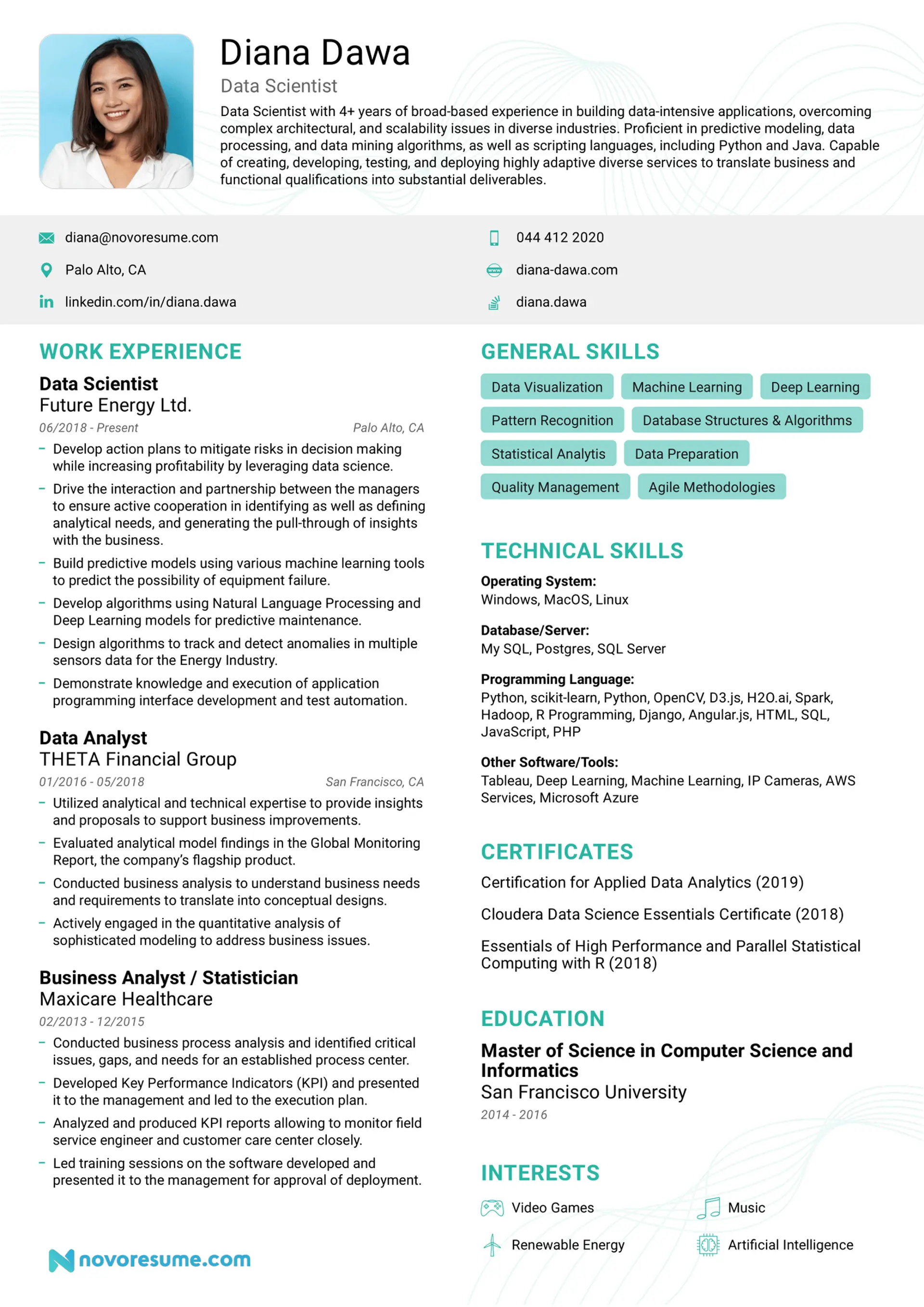
Check out our full guide to writing a data scientist CV here.
#3. Business Analyst CV Example

Check out our full guide to writing a business analyst CV here.
#4. Digital Marketing CV Example

Check out our full guide to writing a digital marketing CV here.
#5. Software Engineer CV Example
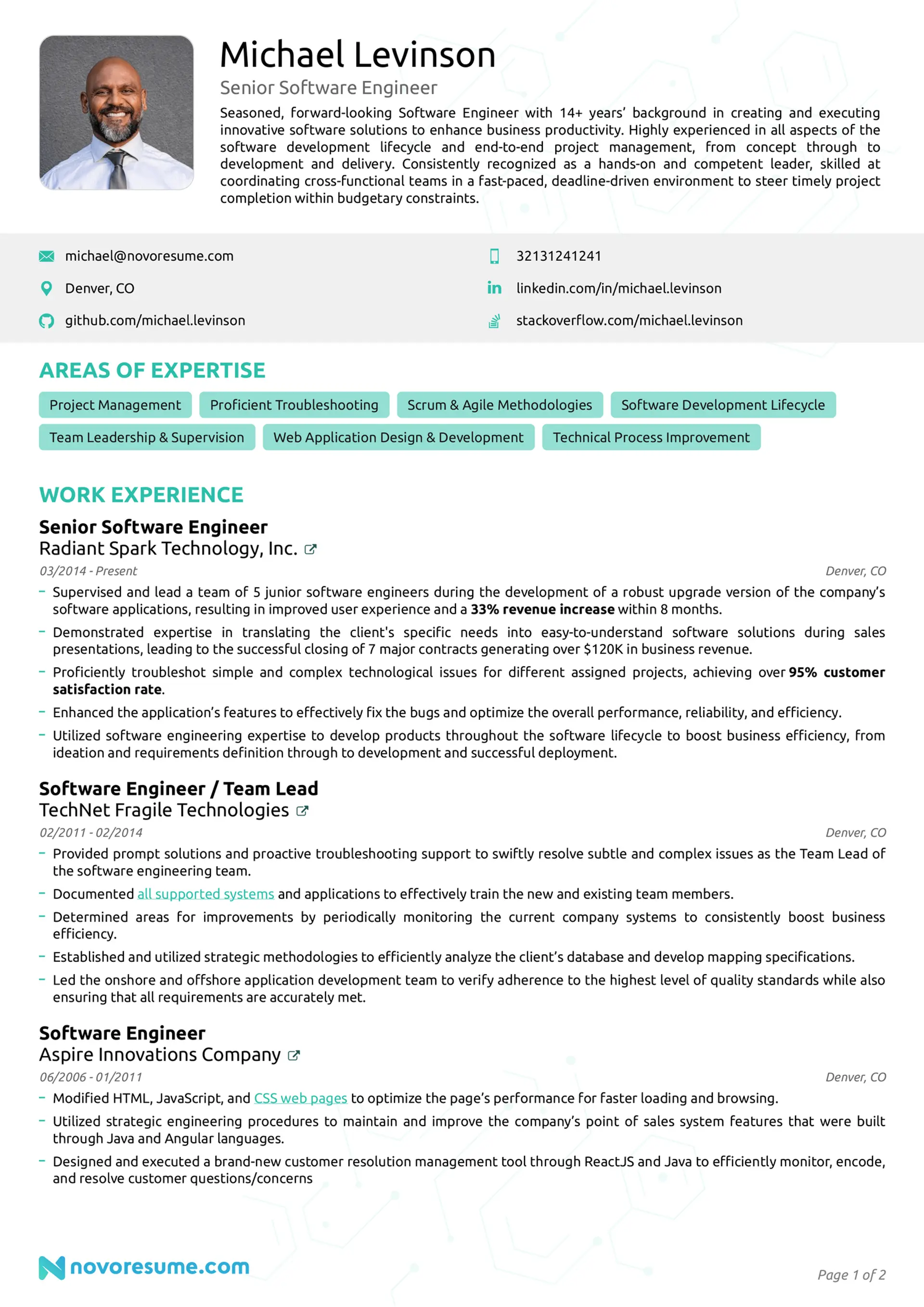
Check out our full guide to writing a software engineer CV here.
#6. Construction Project Manager CV Example
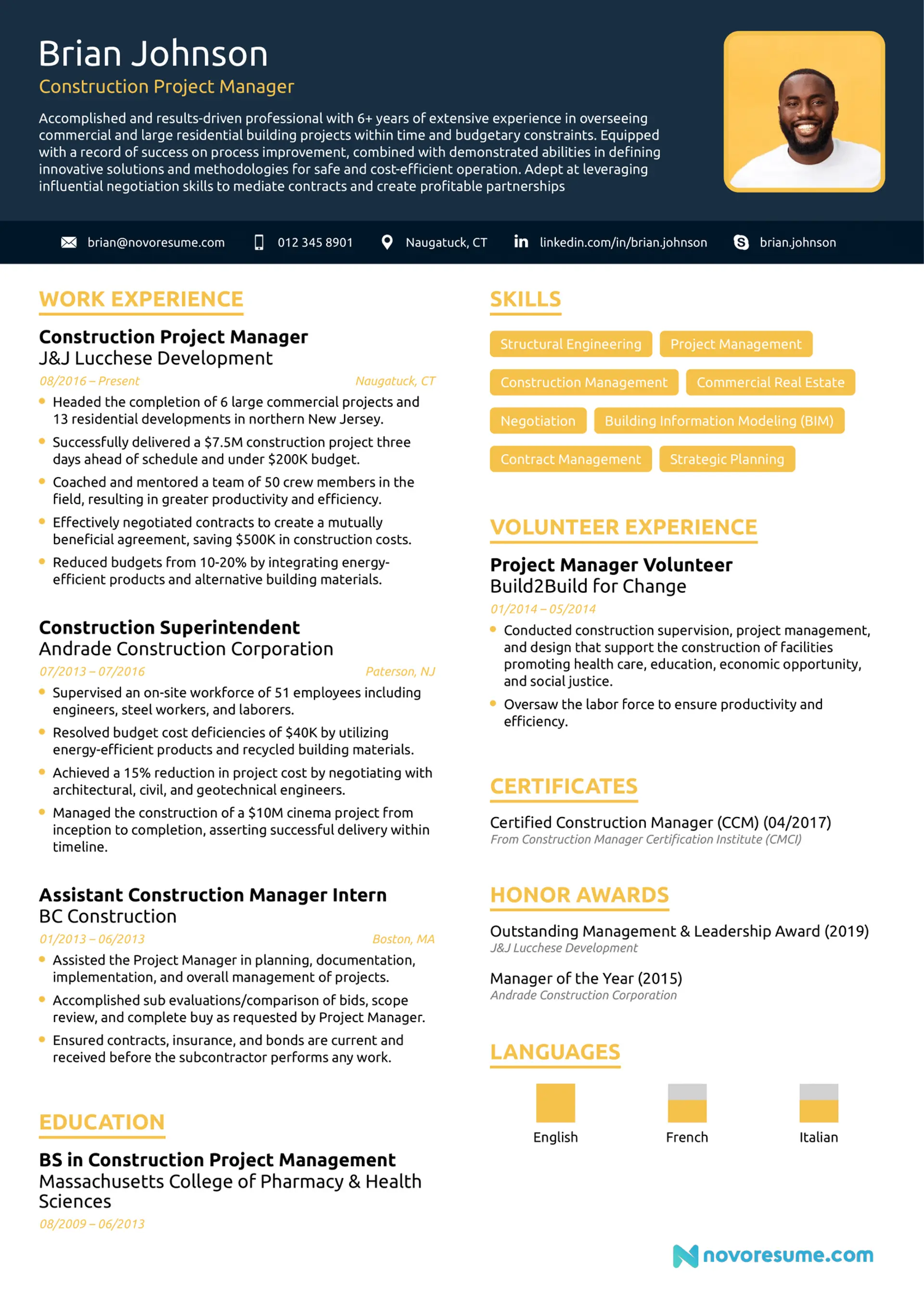
Check out our full guide to writing a construction project manager CV here.
#7. Customer Service CV Example
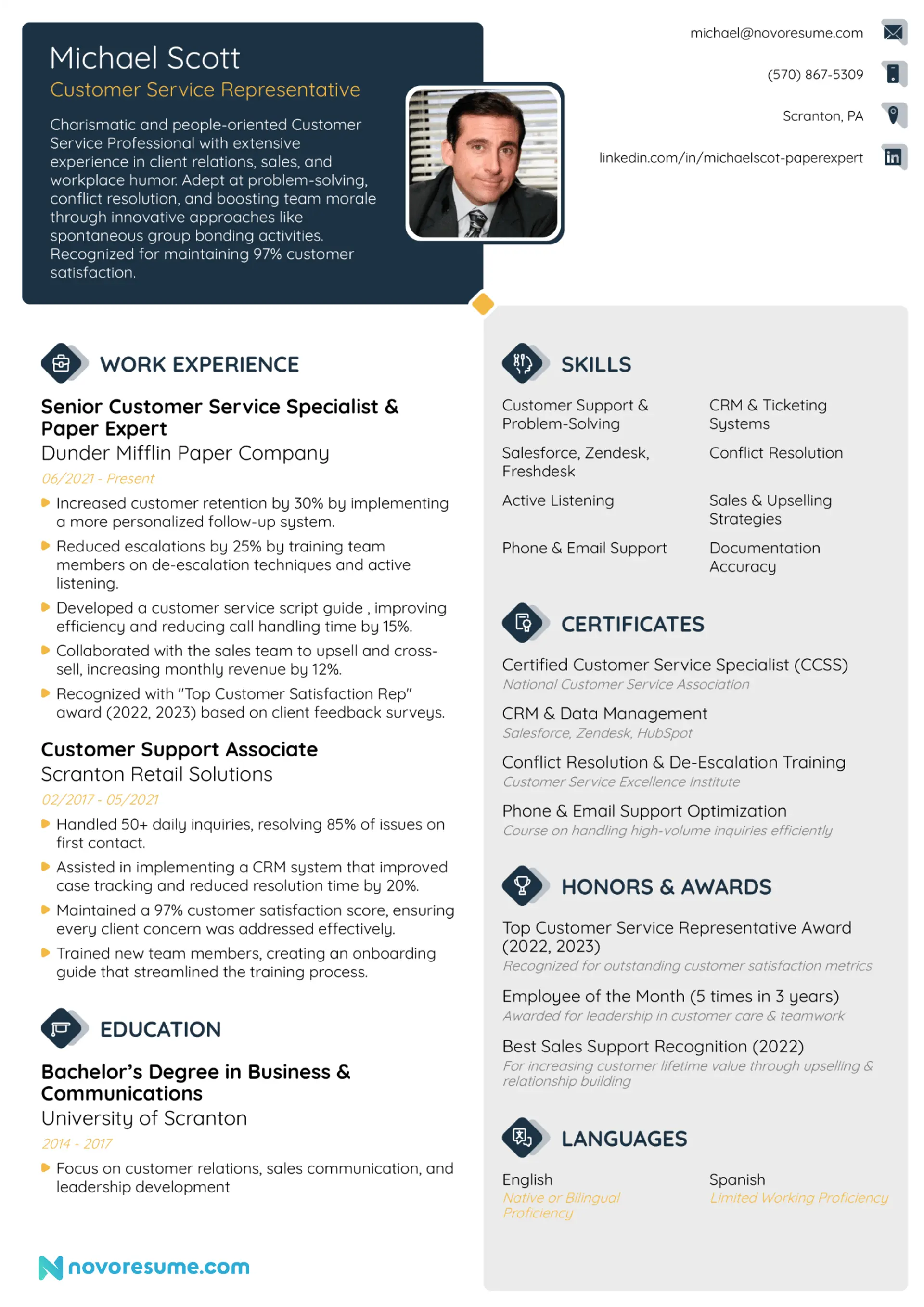
Check out our full guide to writing a customer service CV here.
#8. High School CV Example
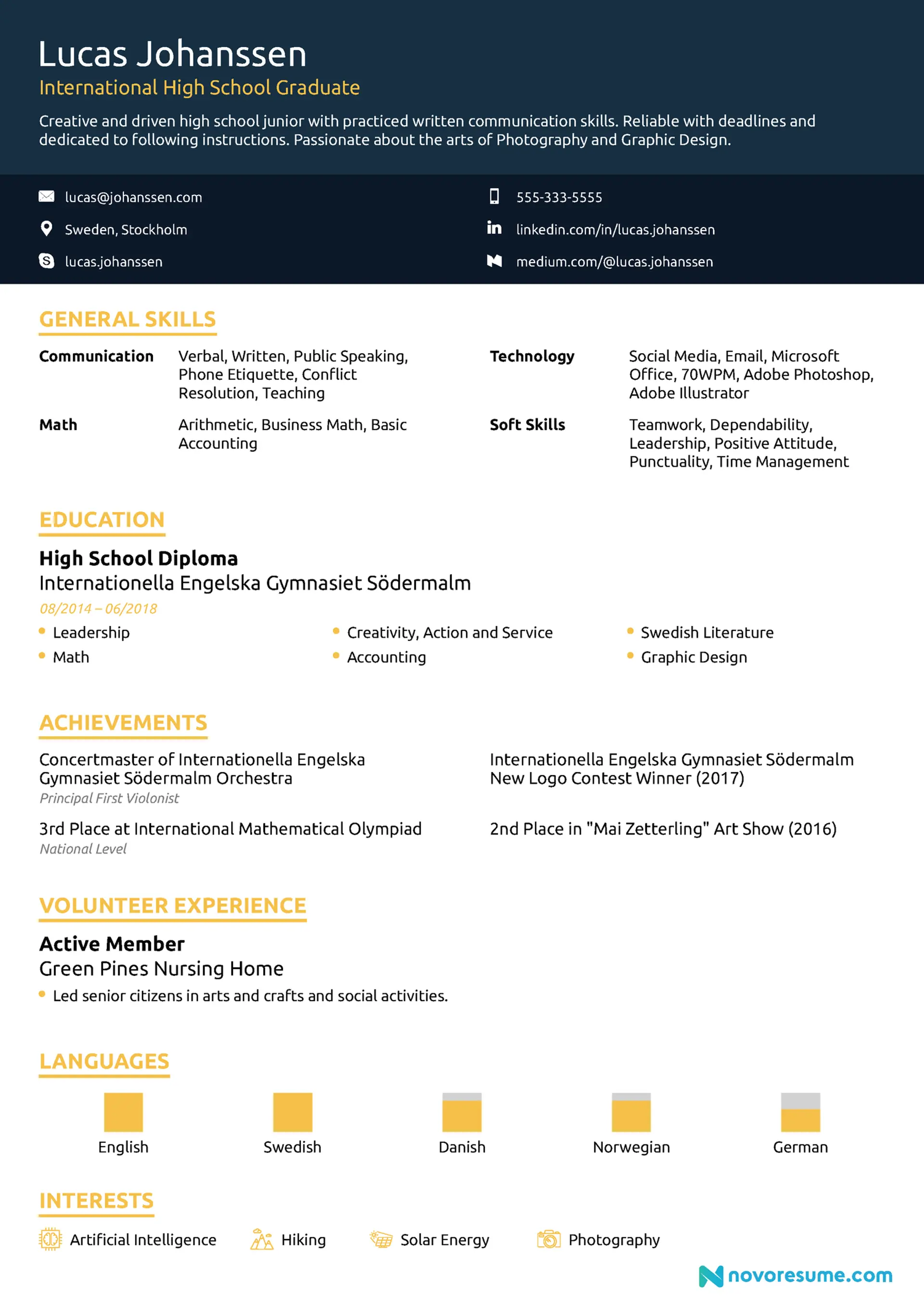
Check out our full guide to writing a high school CV here.
#9. Student CV Example
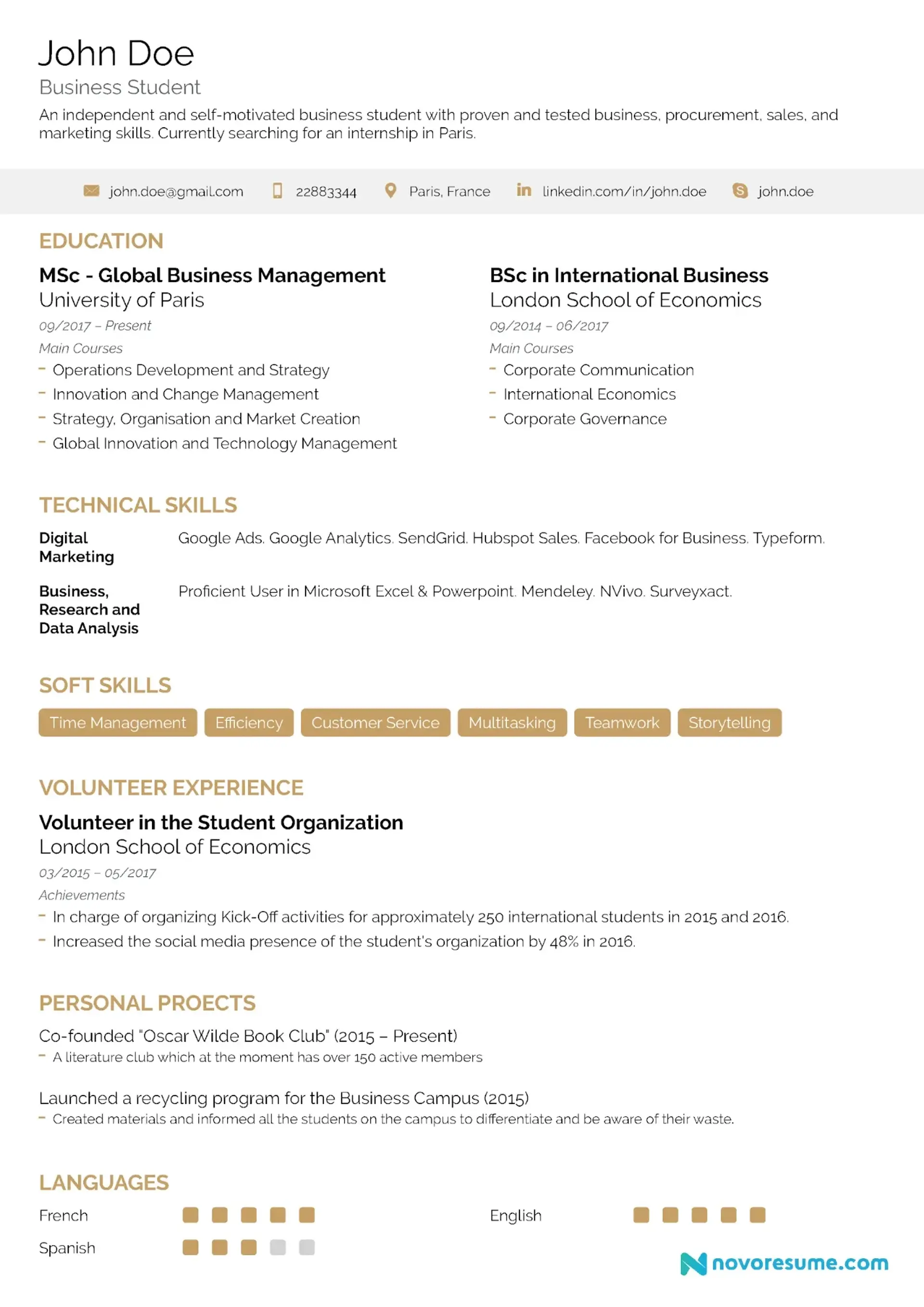
Check out our full guide to writing a student CV here.
#10. Server CV Example
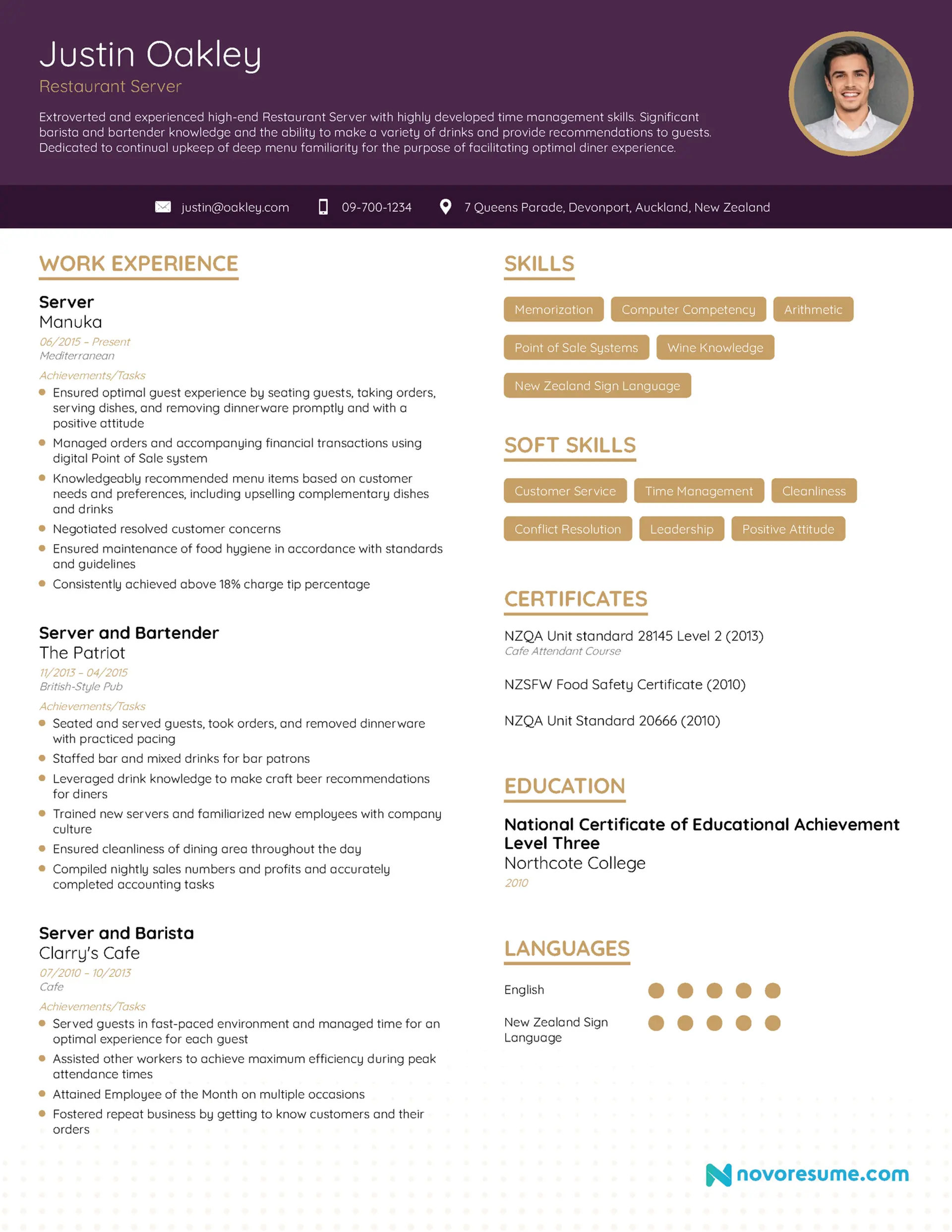
Check out our full guide to writing a server CV here.
#11. Actor CV Example
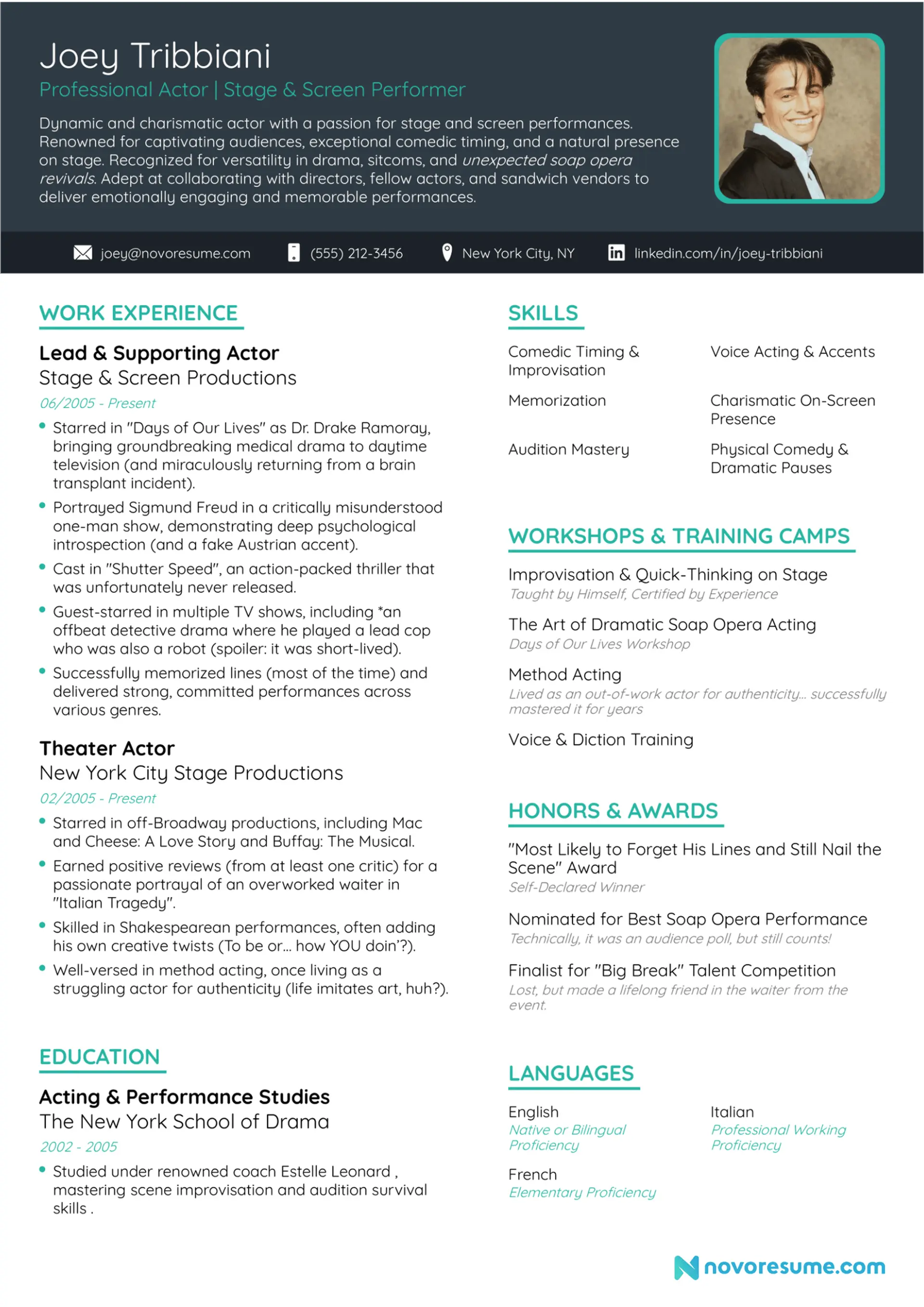
Check out our full guide to writing an actor CV here.
#12. Web Developer CV Example
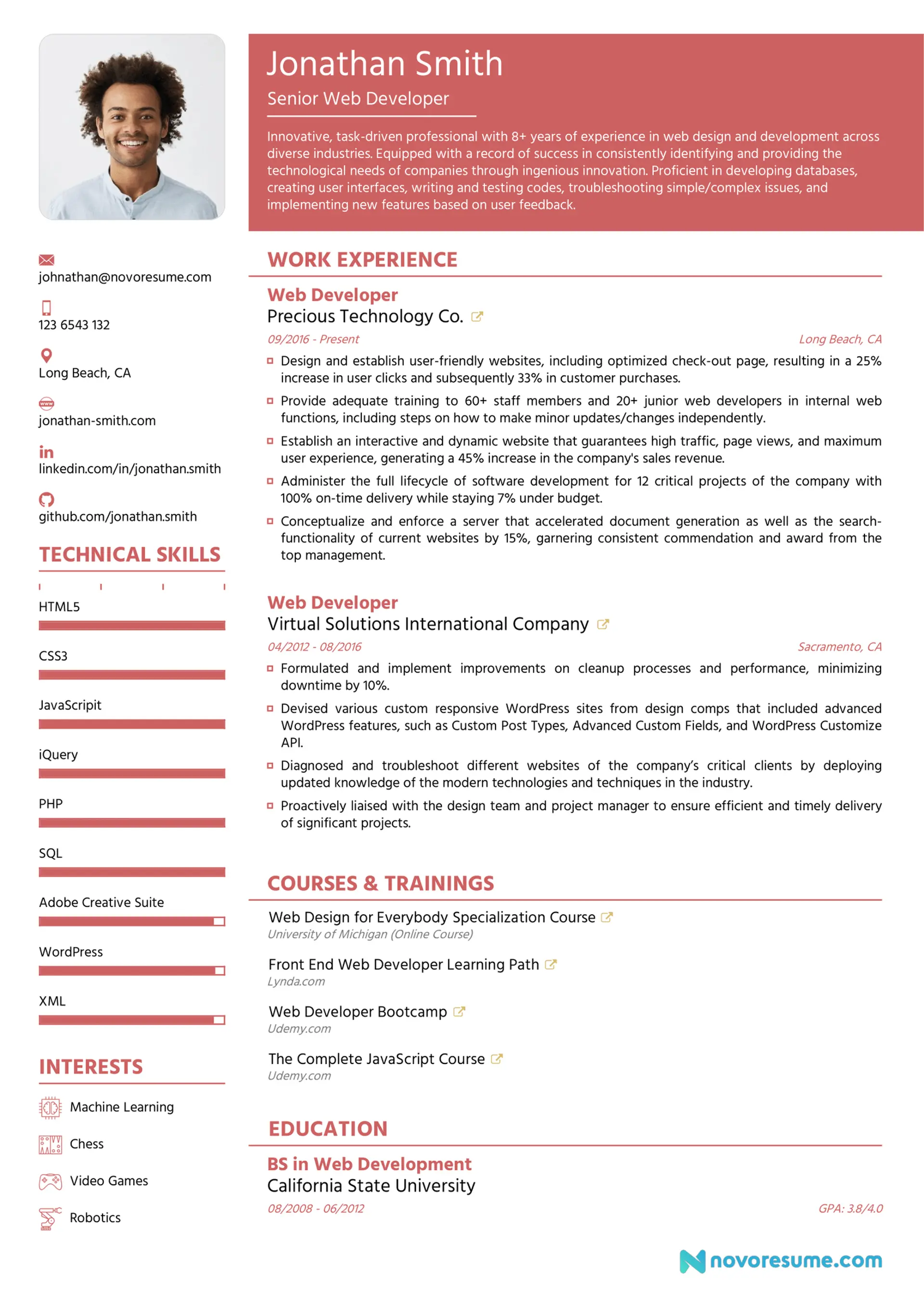
Check out our full guide to writing a web developer CV here.
#13. Engineering CV Example

Check out our full guide to writing an engineering CV here.
#14. Computer Science CV Example

Check out our full guide to writing a computer science CV here.
#15. Architect CV Example
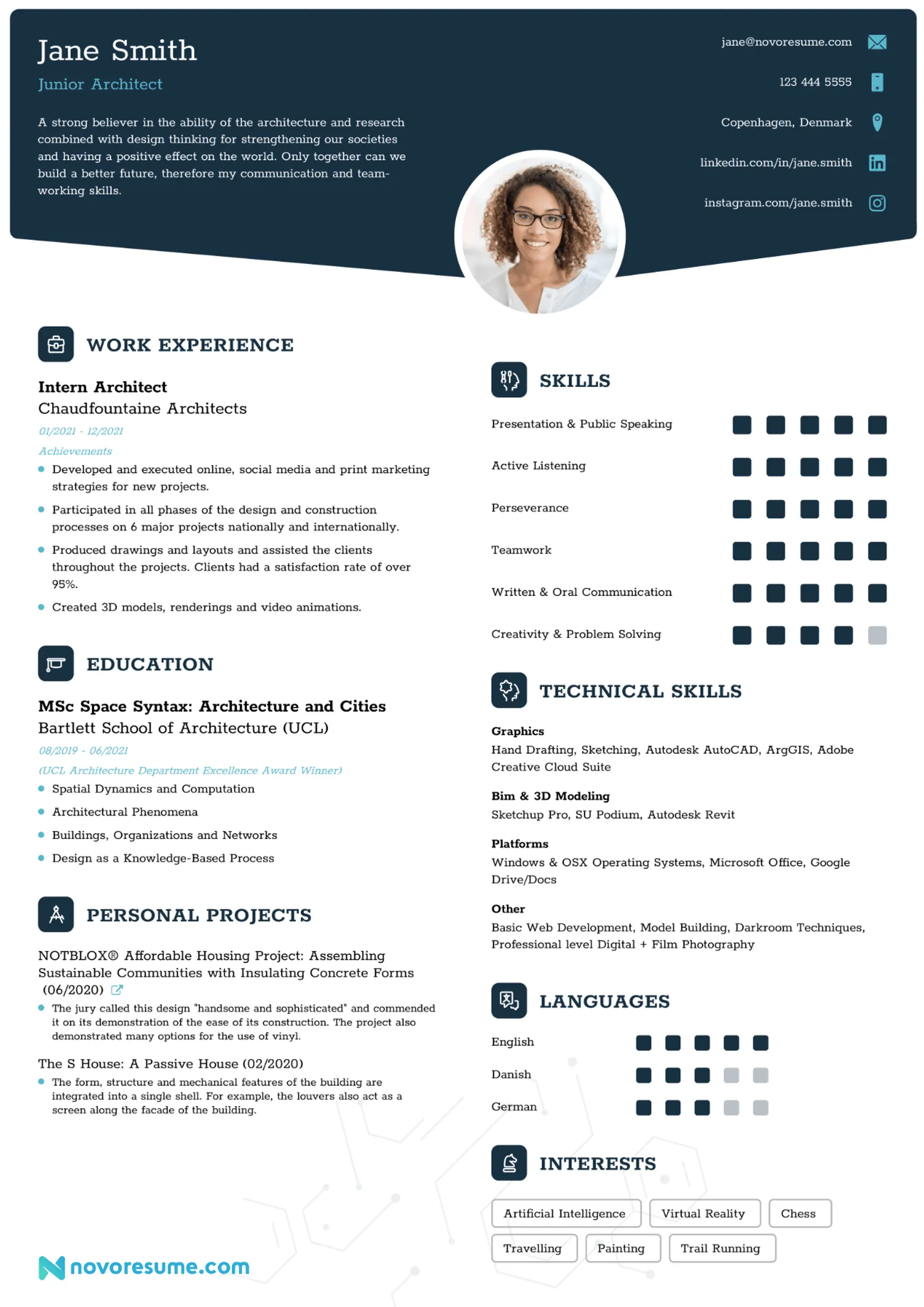
Check out our full guide to writing an architect CV here.
#16. Data Analyst CV Example
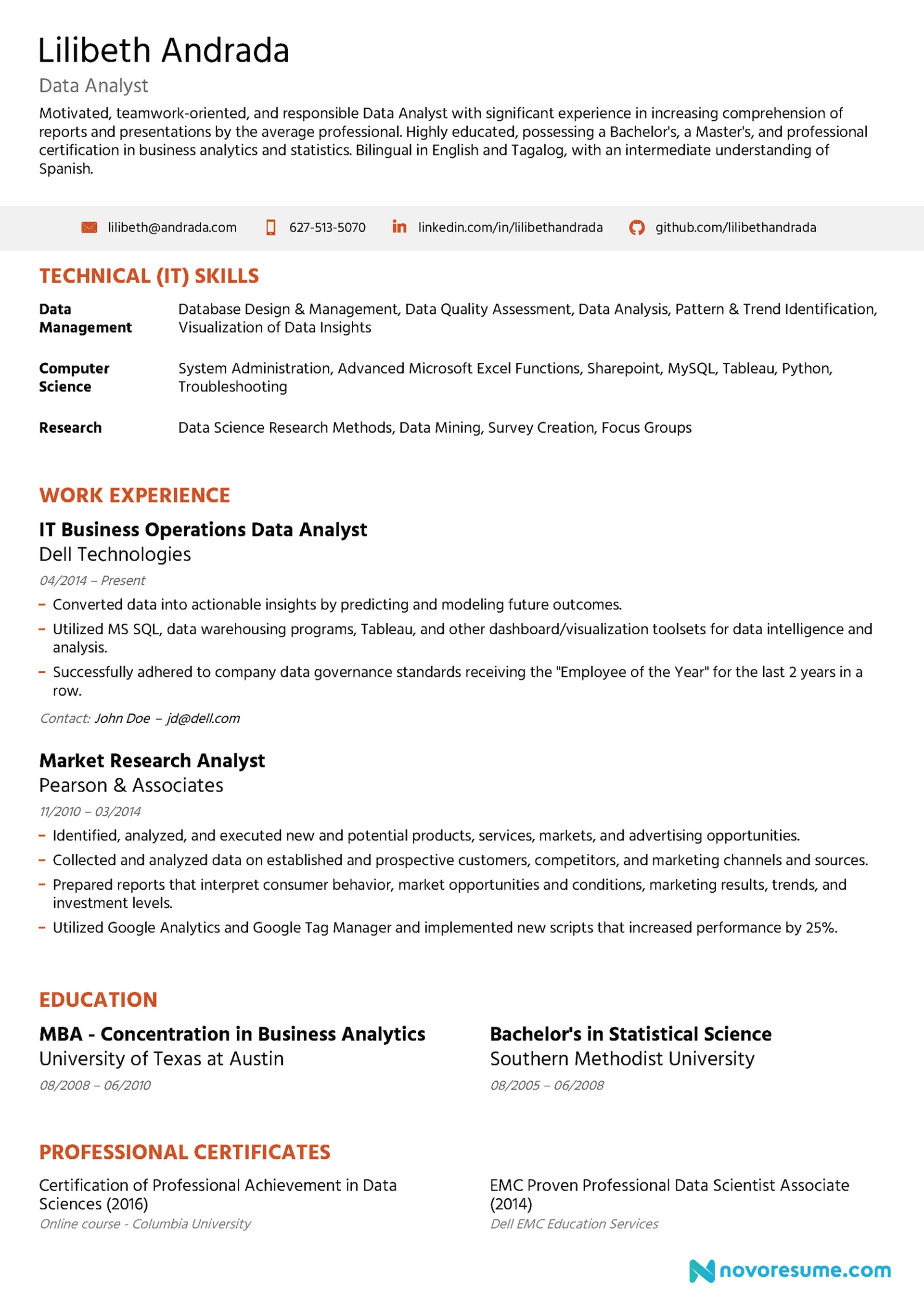
Check out our full guide to writing a data analyst CV here.
#17. Remote Job CV Example

Check out our full guide to writing a remote job CV here.
#18. Sales Associate CV Example
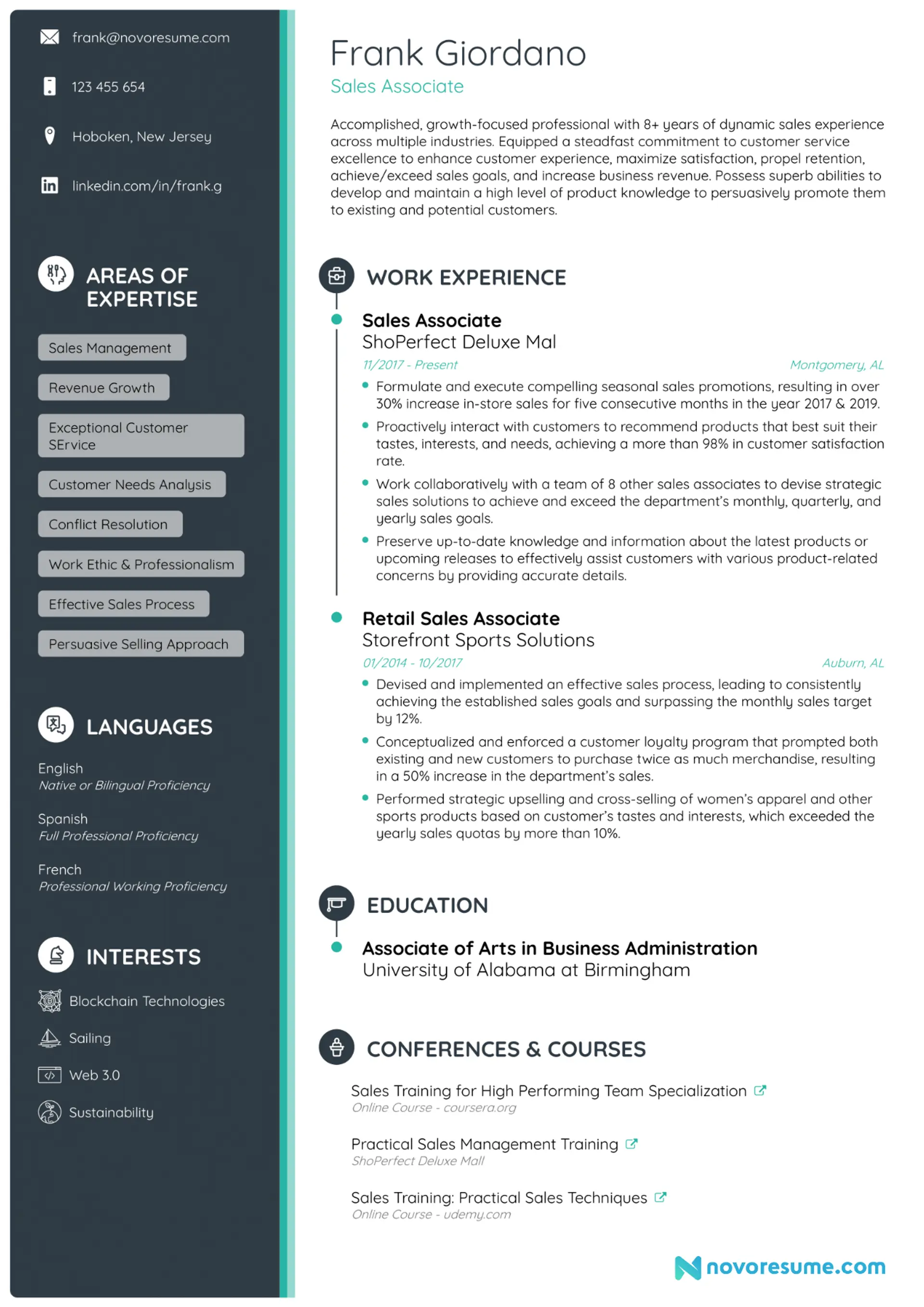
Check out our full guide to writing a sales associate CV here.
#19. Receptionist CV Example

Check out our full guide to writing a receptionist CV here.
Want to see more examples? Check out our compilation of 80+ CV examples for different fields.
- Administrative Assistant CV
- Bartender CV
- DevOps Engineer CV
- Executive Assistant CV
- Flight Attendant CV
- Graphic Designer CV
- Paralegal CV
- Pharmacist CV
- Recruiter CV
- Supervisor CV
Next Steps After Your CV
After you’ve got your CV ready, it’s time to focus on other parts of your job application.
Your CV is the first step in your job search, but to land the job you want, you need to prepare a matching cover letter and nail the upcoming job interview.
#1. Write a Great Cover Letter
The best way to complement your CV is by writing a cover letter.
Now, you might flinch at the idea of having to write a cover letter. Unless you’re looking for a job as a writer, you’re probably not too confident in your ability to write a great cover letter.
Thankfully, writing a cover letter is very easy.
Cover letters act as a direct message to the hiring manager. They should be no more than a single page and use between 250 and 400 words. This gives you the chance to explain, in your own words, why you’re the best candidate for the job.
There are plenty of cover letter tips that can help point you in the right direction, so you’ll be able to write the perfect cover letter in no time.
Just follow this structure:
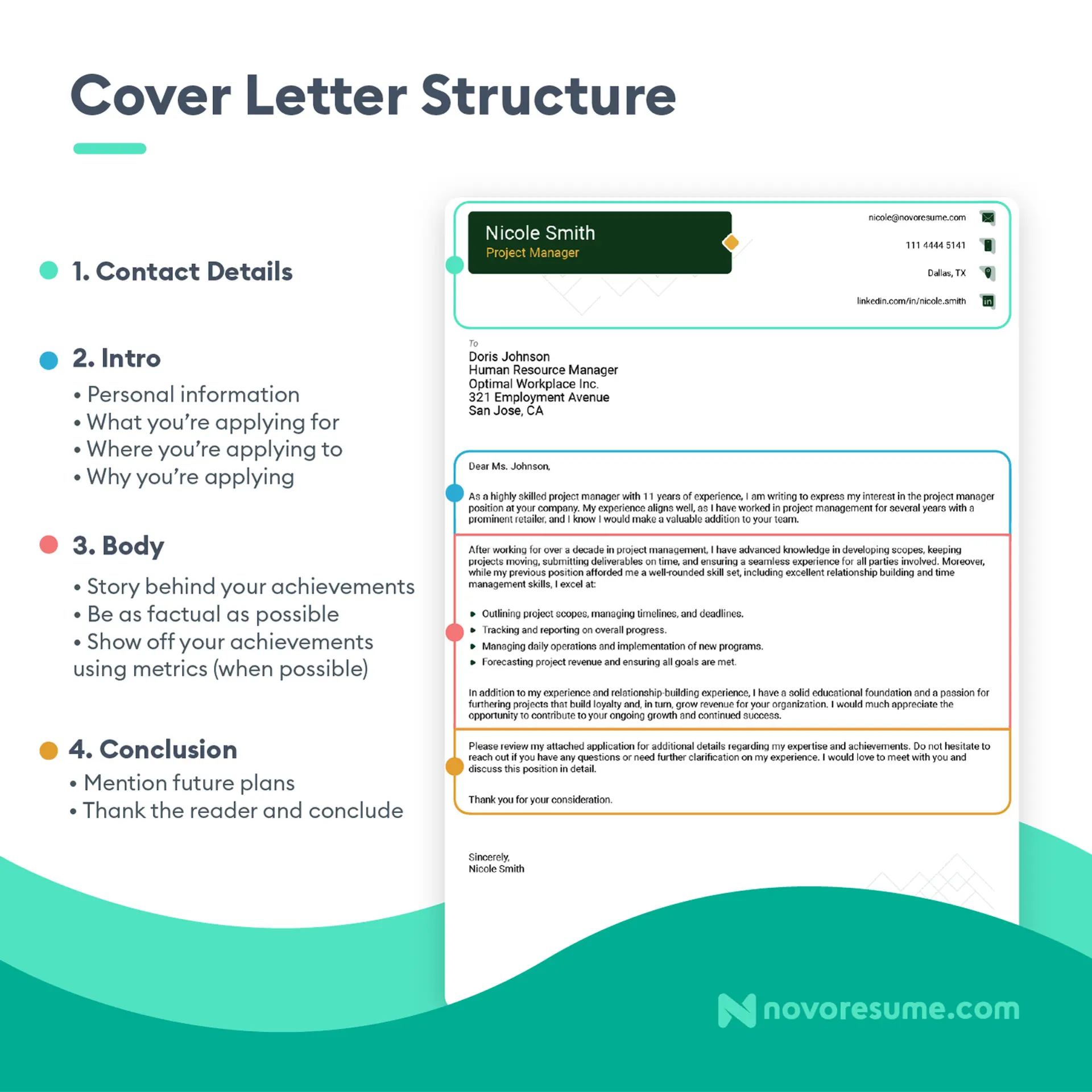
- Include your contact details. Add the same contact information as on your CV, and the contact information of the hiring manager, such as their name, job title, the company’s name, and its general location.
- Present yourself. Start your cover letter by stating who you are, what your relevant work experience is, and what excites you about the position. Include an impressive achievement or two, your crucial skills, and what you can do for the employer’s company.
- Build your case. Check the job ad for the candidate requirements and explain how you meet them. Do research on the company so you actually know what you like about it, and make sure to mention it in your cover letter. Convey your genuine excitement for the opportunity and express your confidence that you can contribute to their mission.
- Conclude it politely. End your cover letter by summarizing how you meet the employer’s needs for a candidate and thanking the hiring manager for their time. Include a call to action, like "Please feel free to contact me at the provided email or phone number so that we may discuss my application in more detail."
- Finally, add a polite closing line and sign your full name underneath.
Not too hard, right? Here’s a real-life example to show you how a cover letter looks:
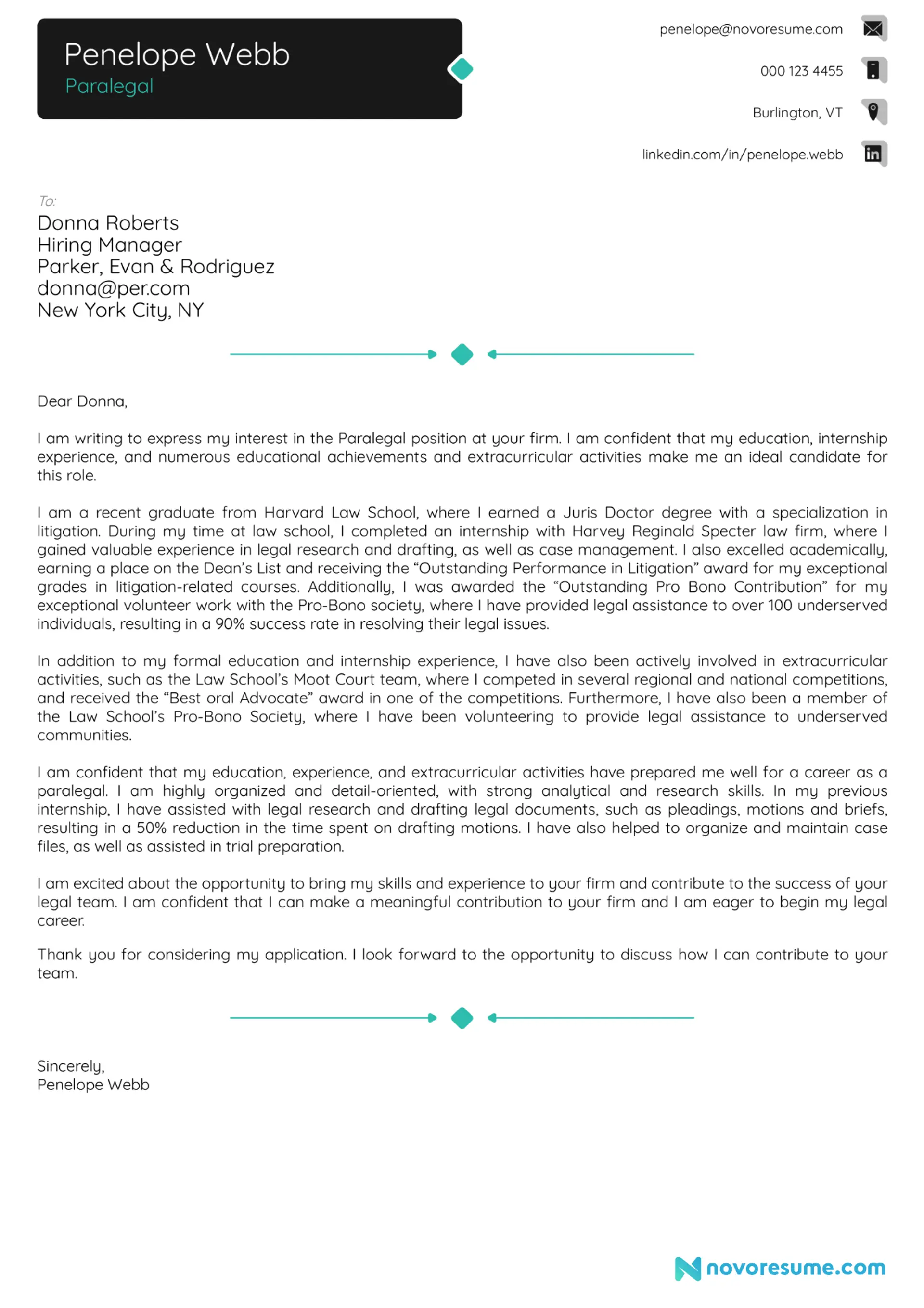
💡
Quick Tip
Want to perfect your cover letter? Learn about the most common cover letter mistakes and check out cover letter examples for different professions here.
#2. Ace The Job Interview
If you’ve made it this far, congratulations are in order. But you can’t celebrate just yet.
The final gatekeeper standing between you and your dream job is the interview process.
If you hate job interviews, you’re not the only one. After all, having to convince a stranger to hire you isn’t most people’s idea of fun.
Here’s the silver lining: most interviewers ask the same questions.
All you have to do is research what the common questions are and show up prepared.
Some of these common interview questions include:
- Why do you want to work here?
- Why should we hire you?
- Tell me about yourself.
- Where do you see yourself in 5 years?
These might sound cliche, but they’re popular questions for a reason.
Interviewers want to get to know you as an employee and determine if you’d fit within their company’s culture.
So, check out our guide to the 35+ Job Interview Questions and Answers and learn how to ace your next interview.
Key Takeaways
At this point, you should feel pretty confident about writing your CV.
The whole process might seem a bit intimidating at first, but now that it’s broken down into bite-sized pieces, we’re sure you’ve got it.
Before we let you go and land that dream job, let’s just recap some of our key points:
- Save time by using a free CV builder to create yours with as few obstacles as possible. There’s no need to mess around with formatting for hours before you even get the chance to write your CV!
- The essential information on your CV includes contact information, a CV summary or objective, work experience, education, and skills. If you have space, you can optionally include sections like certifications, awards, languages, hobbies, and interests.
- Responsibilities aren’t as impressive as achievements, so use your CV to focus on those times you went above and beyond at your job instead of just your daily tasks.
- Always tailor your CV to the specific job you’re applying for. Use the job ad as a reference and emphasize the skills and experience you have that match what the employer is looking for.
- Don’t forget to prepare for the rest of the job application process by writing an equally well-crafted cover letter and practicing how you’ll answer the most common interview questions.
